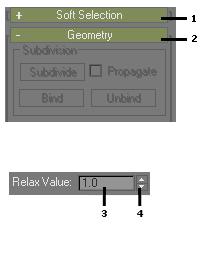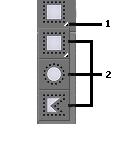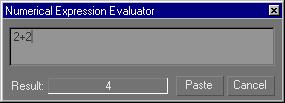
gmax uses some special user interface controls.

1 Collapsed rollout panel
2 Open rollout panel
3 Numeric field
4 Spinner arrows
The program uses several different types of right-click menu.
For object editing, you use the quad menu. Commands on the quad menu vary depending on the kind of object you are editing and the mode you are in.
Right-clicking the label of a viewport displays the Viewport Right-Click Menu, which lets you change viewport display settings, choose which view appears in the viewport, and so on.
Also, command panels and the Material Editor have right-click menus that let you manage rollouts and navigate the panel quickly. And most other windows, including Track View, have right-click menus that provide fast access to commonly used functions.

1 Flyout arrow
2 Flyout buttons
A flyout is similar to a menu, except that the items are buttons. A flyout button is indicated by a small arrow in the lower-right corner. Clicking a button on a flyout makes the button active.
Note: You can define customized text annotations for flyouts by editing the maxstart.cui file. See Customize.

Rollouts are areas in the command panels and dialogs that you can expand (roll out) or collapse (roll in) to manage screen space. In the illustration above, the Keyboard entry rollout is collapsed, as indicated by the + sign, and the Parameters rollout is expanded, as indicated by the û sign.
To open and close rollouts:
Click the rollout title bar to toggle between expanded and collapsed.
Sometimes a command panel or dialog, or the tab panel, is not large enough to display all of its rollouts or tabs. In this case, a pan ("hand") cursor appears over the nonactive parts of the panel. You can scroll command panels and dialogs vertically, and you can scroll a toolbar or the tab panel along its major axis. In addition, you can scroll the tab panel's tabs independently of the active toolbar.
To scroll panels:
Place the pointer over an empty area of a panel to display the pan cursor.
When the pointer becomes a
 , drag the panel up or down.
, drag the panel up or down.
A thin scroll bar also appears on the right side of the scrolling panel. You can use the pointer to drag the scroll bar as well.
To scroll toolbars and tabs:
You can scroll toolbars and the tab panel tabs only when some tool buttons or tabs are not visible. This typically occurs when the program window is smaller than full screen.
First, follow either of the procedures below:
Place the pointer over an empty area of a toolbar or between two tabs to display the pan cursor.
Place the pointer over any part of a toolbar, then press and hold the middle mouse button.
When the pointer becomes a
 , drag the Main toolbar or tab row horizontally.
, drag the Main toolbar or tab row horizontally.

A spinner is a control for numeric fields. You can click or drag the spinner arrows to change the value in the field.
To change a value using a spinner, do any of the following:
Click the spinner to increment or decrement the value.
Drag up to increase the value, or drag down to decrease it.
Press CTRL while you drag to increase the rate at which the value changes.
Press ALT while you drag to decrease the rate at which the value changes.
Right-click a spinner to reset the field to its minimum value.
While a spinner is active, you can display a calculator called the Numerical Expression Evaluator. To display the calculator, press CTRL+N.

The expression you enter is evaluated, and its result is displayed in the Result field. Clicking Paste replaces the spinner value with the result of the calculation. Clicking Cancel exits the Expression Evaluator.
The expressions you can enter are like the expressions used with MAXScript or the Expression Controller. You can't use variables in the Expression Evaluator, but you can enter the constants pi (circular ratio), e (natural logarithm base), and TPS (ticks per second). These constants are case-sensitive: the Expression Evaluator does not recognize PI, E, or tps.
You can also enter a vector expression or an Expression Controller function call, but the result of the expression or function must be a scalar value. Otherwise, the Expression Evaluator won't evaluate it.
You can change a numeric value by a relative offset by typing R or r followed by the offset amount.
For example, a radius field shows 70 and you highlight it:
If you type R30, 30 is added to the radius and the value changes to 100.
If you type Rû30, 30 is subtracted from the radius and the value changes to 40.
The gmax interface uses color cues to remind you what state the program is in.
Note: You can customize most of these colors by using the Colors panel of the Customize User Interface dialog.
Red for animation: The Animate button, the time slider background, and the border of the active viewport turn red when you are in Animate mode.
Gold for modal function buttons: When you turn on a button that puts you in a generic creation or editing mode, the button turns gold.
Yellow for special action modes: When you turn on a button that alters the normal behavior of other functions, the button is highlighted in yellow. Common examples of this behavior include sub-object selection and locking your current selection set.
You can exit a functional mode by clicking another modal button. Other exit methods supported by some buttons include right-clicking in a viewport, or clicking the modal button a second time.
You can easily undo changes you make to your scene and your viewports. The software manages separate Undo buffers for both the scene objects and each viewport.
Use the Main toolbar Undo and Redo buttons or the Edit menu > Undo and Redo commands to reverse the effects of most scene operations. You can also use CTRL+Z for Undo and CTRL+A for Redo. Most things you do in the program can be undone.
Use the Views menu > Undo and Redo commands to reverse the effects of most viewport operations, such as zooming and panning. You can also use SHIFT+Z for Undo View Change and SHIFT+A for Redo View Change.
You can also undo actions by using the Hold and Fetch commands on the Edit menu. Choose Edit menu > Hold to save a copy of your scene in a temporary file. Then choose Edit menu > Fetch to discard your current scene and revert to the held scene at any time.